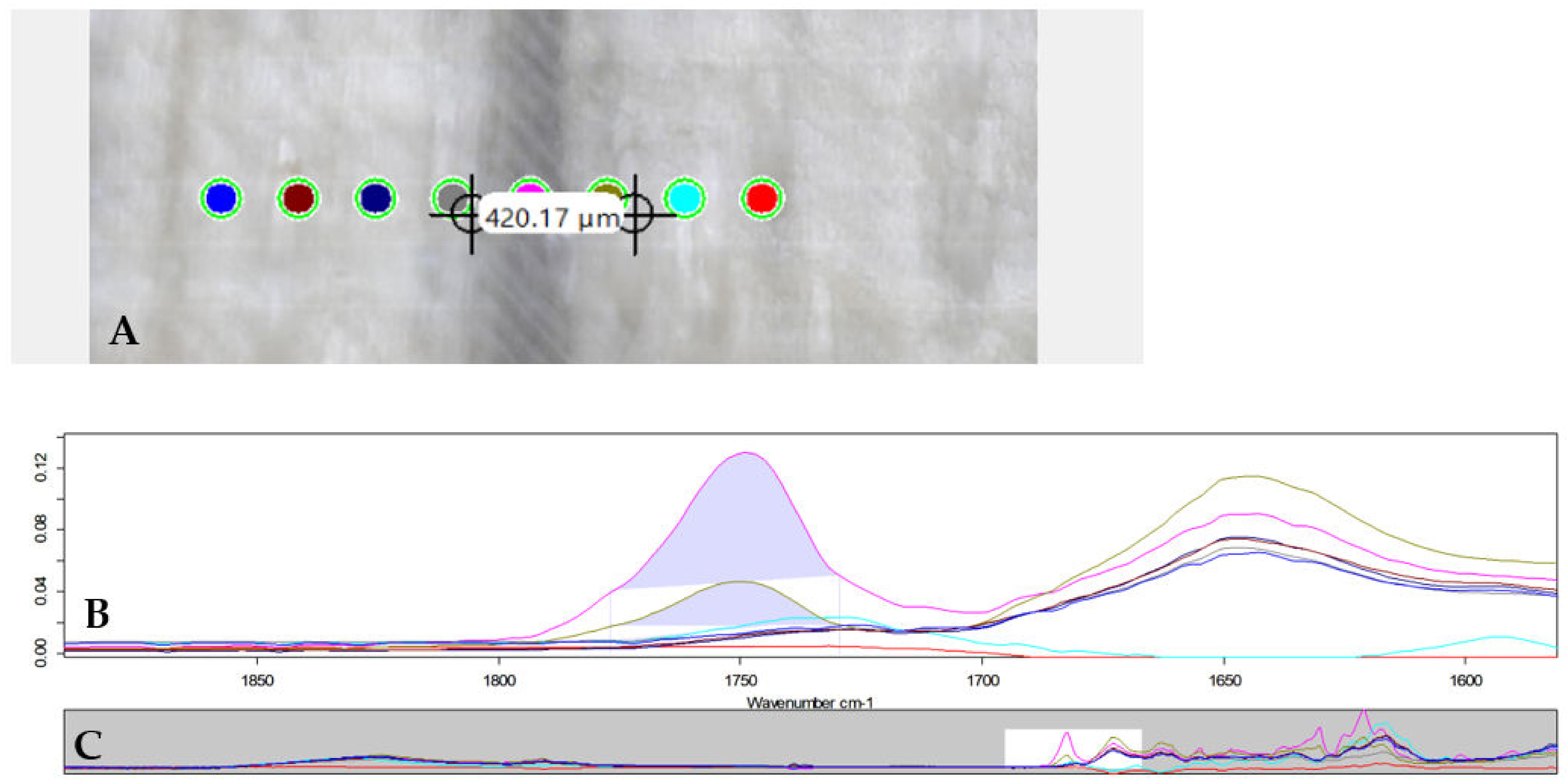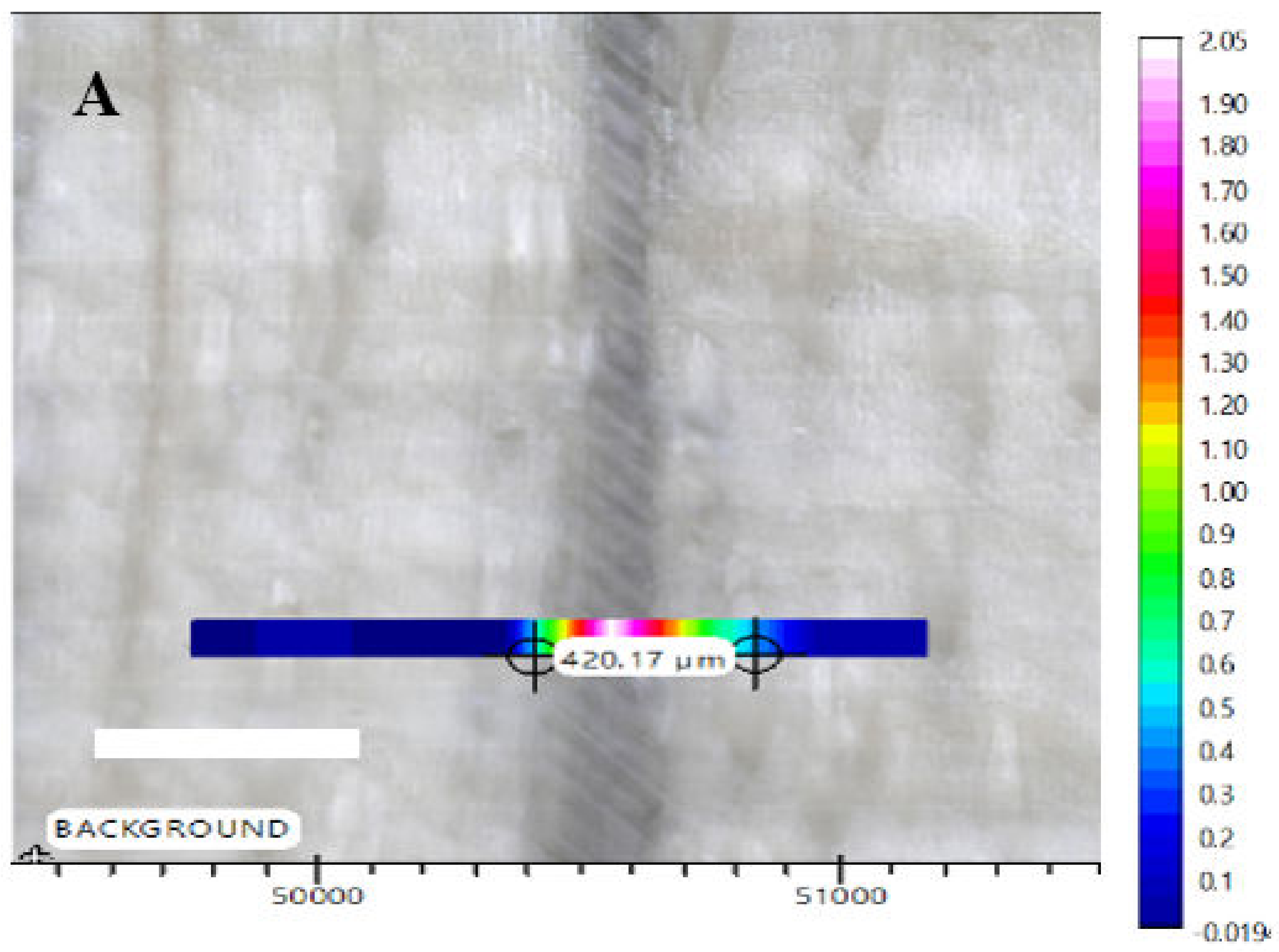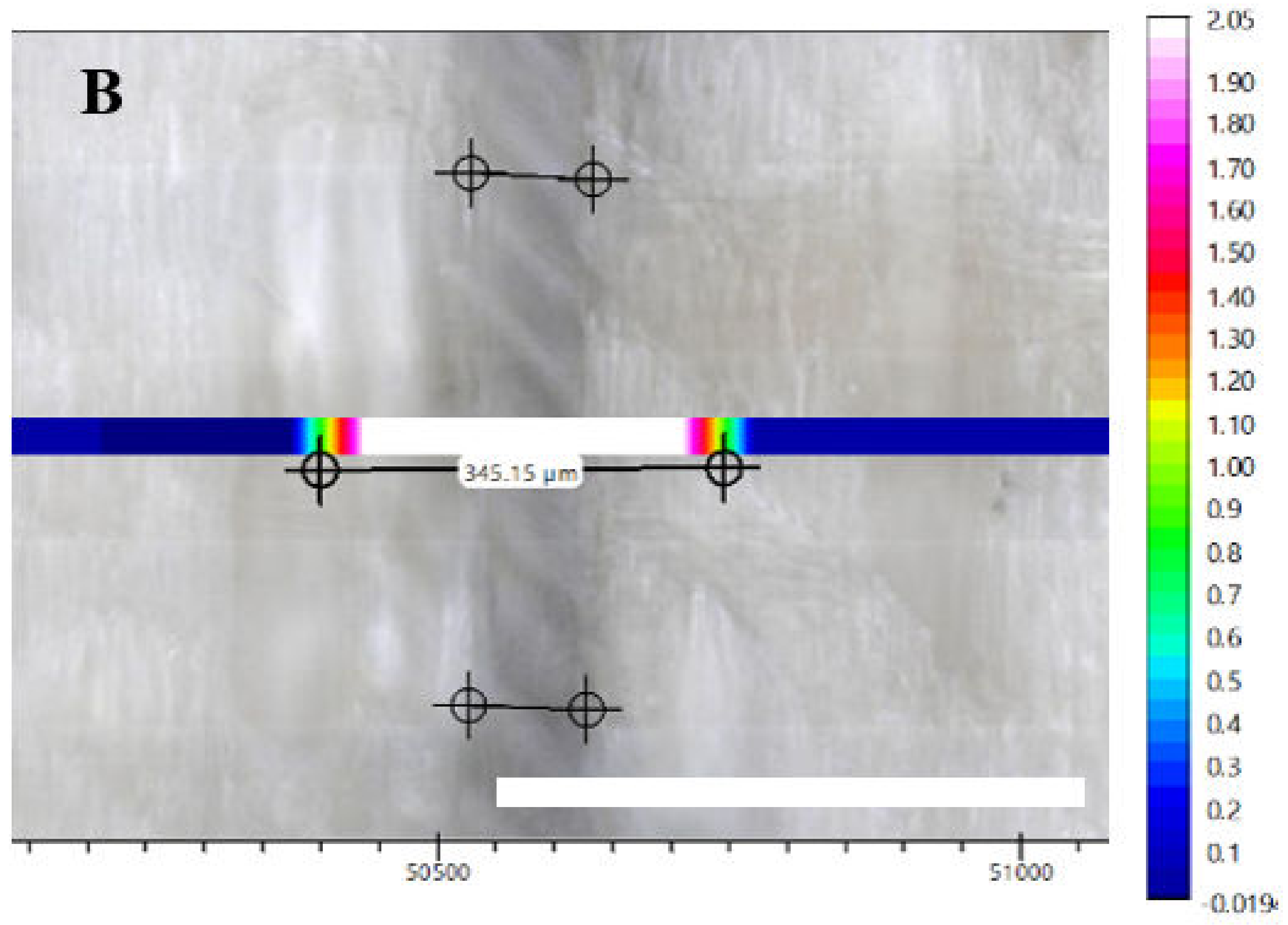Chemical Imaging of the Polylactic Acid − Wood Adhesion Interface of Bonded Veneer Products
Abstract
:1. Introduction
2. Results
2.1. Microscopy Assessments of PLA Bondlines
2.2. Qualitative Assessment of PLA Adhesion Interface Using Chemical Imaging
3. Conclusions
Supplementary Materials
Author Contributions
Funding
Institutional Review Board Statement
Informed Consent Statement
Data Availability Statement
Acknowledgments
Conflicts of Interest
References
- Bishop, G.; Styles, D.; Lens, P.N.L. Environmental performance comparison of bioplastics and petrochemical plastics: A review of life cycle assessment (LCA) methodological decisions. Resour. Conserv. Recycl. 2021, 168, 105451. [Google Scholar] [CrossRef]
- Nagarajan, V.; Mohanty, A.K.; Misra, M. Perspective on Polylactic Acid (PLA) based Sustainable Materials for Durable Applications: Focus on Toughness and Heat Resistance. ACS Sustain. Chem. Eng. 2016, 4, 2899–2916. [Google Scholar] [CrossRef]
- Sin, L.T.; Tueen, B.S. (Eds.) 2—Synthesis and Production of Poly(Lactic Acid). In Polylactic Acid, 2nd ed.; William Andrew Publishing: Norwich, NY, USA, 2019; pp. 53–95. [Google Scholar]
- Chan, C.M.; Vandi, L.J.; Pratt, S.; Halley, P.; Richardson, D.; Werker, A.; Laycock, B. Composites of Wood and Biodegradable Thermoplastics: A Review. Polym. Rev. 2018, 58, 444–494. [Google Scholar] [CrossRef]
- Hubbe, M.A.; Grigsby, W. From Nanocellulose to Wood Particles: A Review of Particle Size vs. the Properties of Plastic Composites Reinforced with Cellulose-based Entities. Bioresources 2019, 15, 52. [Google Scholar] [CrossRef]
- Grigsby, W.; Gager, V.; Recabar, K.; Krause, A.; Gaugler, M.; Luedtke, J. Quantitative Assessment and Visualisation of the Wood and Poly(Lactic Acid) Interface in Sandwich Laminate Composites. Fibers 2019, 7, 15. [Google Scholar] [CrossRef] [Green Version]
- Luedtke, J.; Gaugler, M.; Grigsby, W.J.; Krause, A. Understanding the development of interfacial bonding within PLA/wood-based thermoplastic sandwich composites. Ind. Crops Prod. 2019, 127, 129–134. [Google Scholar] [CrossRef]
- Bakken, A.C.; Taleyarkhan, R.P. Plywood wood based composites using crystalline/amorphous PLA polymer adhesives. Int. J. Adhes. Adhes. 2020, 99, 102581. [Google Scholar] [CrossRef]
- Peltola, H.; Pääkkönen, E.; Jetsu, P.; Heinemann, S. Wood based PLA and PP composites: Effect of fibre type and matrix polymer on fibre morphology, dispersion and composite properties. Compos. Part A Appl. Sci. Manuf. 2014, 61, 13–22. [Google Scholar] [CrossRef]
- Tao, Y.; Wang, H.; Li, Z.; Li, P.; Shi, S.Q. Development and application of wood flour-filled polylactic acid composite filament for 3d printing. Materials 2017, 10, 339. [Google Scholar] [CrossRef] [PubMed] [Green Version]
- Gaugler, M.; Luedtke, J.; Grigsby, W.J.; Krause, A. A new methodology for rapidly assessing interfacial bonding within fibre-reinforced thermoplastic composites. Int. J. Adhes. Adhes. 2019, 89, 66–71. [Google Scholar] [CrossRef]
- Mamiński, M.Ł.; Novák, I.; Mičušík, M.; Małolepszy, A.; Toczyłowska-Mamińska, R. Discharge Plasma Treatment as an Efficient Tool for Improved Poly(lactide) Adhesive–Wood Interactions. Materials 2021, 14, 3672. [Google Scholar] [CrossRef] [PubMed]
- Kamke, F.A.; Lee, J.N. Adhesive penetration in wood—A review. Wood Fiber Sci. 2007, 39, 205–220. [Google Scholar]
- Gowen, A.A.; Feng, Y.; Gaston, E.; Valdramidis, V. Recent applications of hyperspectral imaging in microbiology. Talanta 2015, 137, 43–54. [Google Scholar] [CrossRef] [PubMed]
- Kazarian, S.G.; Chan, K.L.A. ATR-FTIR spectroscopic imaging: Recent advances and applications to biological systems. Analyst 2013, 138, 1940–1951. [Google Scholar] [CrossRef] [PubMed]
- Bonifazi, G.; Calienno, L.; Capobianco, G.; Monaco, A.L.; Pelosi, C.; Picchio, R.; Serranti, S. A new approach for the modelling of chestnut wood photo-degradation monitored by different spectroscopic techniques. Environ. Sci. Pollut. Res. 2017, 24, 13874–13884. [Google Scholar] [CrossRef] [PubMed]
- Mäkelä, M.; Altgen, M.; Belt, T.; Rautkari, L. Hyperspectral imaging and chemometrics reveal wood acetylation on different spatial scales. J. Mater. Sci. 2021, 56, 5053–5066. [Google Scholar] [CrossRef]
- Gaugler, M.; Grigsby, W.; Harper, D.; Rials, T. Chemical imaging of the spatial distribution and interactions of tannin dispersal in bioplastic systems. Adv. Mater. Process. IV 2007, 29–30, 173–176. [Google Scholar]
- Grigsby, W.J.; Puri, A.; Gaugler, M.; Lüedtke, J.; Krause, A. Bonding Wood Veneer with Biobased Poly(Lactic Acid) Thermoplastic Polyesters: Potential Applications for Consolidated Wood Veneer and Overlay Products. Fibers 2020, 8, 50. [Google Scholar] [CrossRef]




| PLA | Pressing Temperature | Outer Bondlines Thickness | Inner Bondline Thickness | ||
|---|---|---|---|---|---|
| Type | (°C) | Average (μm) | Std. Dev. | Average (μm) | Std. Dev. |
| Birch Samples | |||||
| Amorphous | 140 | 130 | 23 | 167 | 15 |
| 160 | 79 | 17 | 80 | 11 | |
| 180 | 42 | 14 | 42 | 10 | |
| Semi-Crystalline | 140 | 193 | 32 | 161 | 26 |
| 160 | 54 | 18 | 42 | 13 | |
| 180 | 31 | 10 | 30 | 4 | |
| Spruce Samples | |||||
| Amorphous | 140 | 85 | 21 | 112 | 35 |
| 160 | 51 | 15 | 56 | 18 | |
| 180 | 27 | 13 | 39 | 21 | |
| Semi-Crystalline | 140 | 163 | 21 | 171 | 15 |
| 160 | 27 | 2 | 35 | 7 | |
| 180 | 26 | 13 | 27 | 9 | |
| PLA Type | Pressing Temperature (°C) | Light Microscopy Bondline (μm) | FTIR Bondline (μm) | PLA Interphase (μm) | Calc. PLA Penetration (μm) | |||
|---|---|---|---|---|---|---|---|---|
| Average | Std. Dev. | Average | Std. Dev. | Average | Std. Dev. | Average | ||
| Amorphous | 140 | 167 | 15 | 110 | 7 | 233 | - | 62 |
| 160 | 80 | 11 | 122 | 33 | 383 | 53 | 130 | |
| 180 | 42 | 10 | 61 | 4 | 422 | 17 | 181 | |
| Semi-Crystalline | 140 | 161 | 26 | 159 | 20 | 315 | - | 78 |
| 160 | 52 | 13 | 143 | 32 | 515 | - | 186 | |
Publisher’s Note: MDPI stays neutral with regard to jurisdictional claims in published maps and institutional affiliations. |
© 2022 by the authors. Licensee MDPI, Basel, Switzerland. This article is an open access article distributed under the terms and conditions of the Creative Commons Attribution (CC BY) license (https://creativecommons.org/licenses/by/4.0/).
Share and Cite
Grigsby, W.J.; Torayno, D.; Gaugler, M.; Luedtke, J.; Krause, A. Chemical Imaging of the Polylactic Acid − Wood Adhesion Interface of Bonded Veneer Products. Fibers 2022, 10, 17. https://doi.org/10.3390/fib10020017
Grigsby WJ, Torayno D, Gaugler M, Luedtke J, Krause A. Chemical Imaging of the Polylactic Acid − Wood Adhesion Interface of Bonded Veneer Products. Fibers. 2022; 10(2):17. https://doi.org/10.3390/fib10020017
Chicago/Turabian StyleGrigsby, Warren J., Desiree Torayno, Marc Gaugler, Jan Luedtke, and Andreas Krause. 2022. "Chemical Imaging of the Polylactic Acid − Wood Adhesion Interface of Bonded Veneer Products" Fibers 10, no. 2: 17. https://doi.org/10.3390/fib10020017






